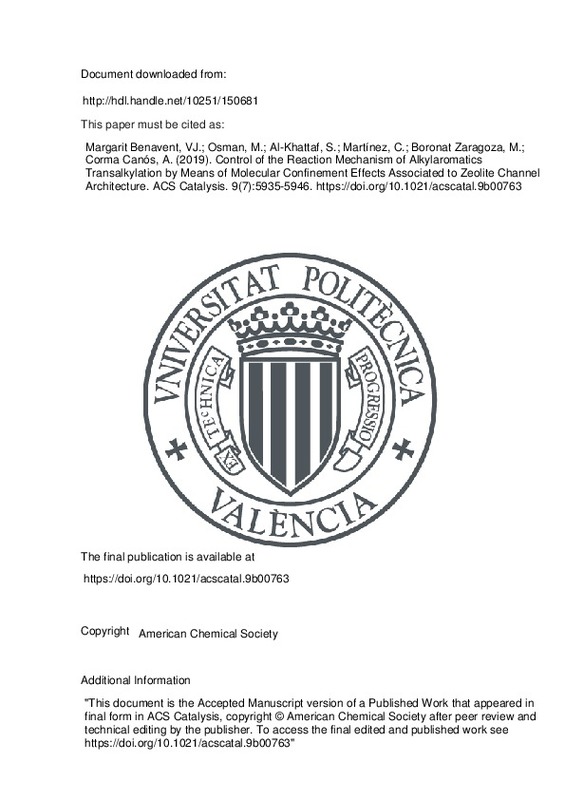JavaScript is disabled for your browser. Some features of this site may not work without it.
Buscar en RiuNet
Listar
Mi cuenta
Estadísticas
Ayuda RiuNet
Admin. UPV
Control of the Reaction Mechanism of Alkylaromatics Transalkylation by Means of Molecular Confinement Effects Associated to Zeolite Channel Architecture
Mostrar el registro sencillo del ítem
Ficheros en el ítem
| dc.contributor.author | Margarit Benavent, Vicente Juan
|
es_ES |
| dc.contributor.author | OSMAN, MOGAHID
|
es_ES |
| dc.contributor.author | Al-Khattaf, Sulaiman
|
es_ES |
| dc.contributor.author | Martínez, Cristina
|
es_ES |
| dc.contributor.author | Boronat Zaragoza, Mercedes
|
es_ES |
| dc.contributor.author | Corma Canós, Avelino
|
es_ES |
| dc.date.accessioned | 2020-09-24T12:30:36Z | |
| dc.date.available | 2020-09-24T12:30:36Z | |
| dc.date.issued | 2019-07-05 | es_ES |
| dc.identifier.issn | 2155-5435 | es_ES |
| dc.identifier.uri | http://hdl.handle.net/10251/150681 | |
| dc.description | "This document is the Accepted Manuscript version of a Published Work that appeared in final form in ACS Catalysis, copyright © American Chemical Society after peer review and technical editing by the publisher. To access the final edited and published work see https://doi.org/10.1021/acscatal.9b00763" | es_ES |
| dc.description.abstract | [EN] Transalkylation of alkylaromatics catalyzed by acid zeolites is a process widely employed in the petrochemical industry for upgrading aromatic fractions. The reaction mechanism is complex as it can proceed either by intermolecular alkyl-transfer involving dealkylation-alkylation steps with surface alkoxy species as reaction intermediates or through the formation of bulkier diaryl intermediates. We have investigated how the possible formation of such bulky intermediates in the microporous channel system of different zeolite structures, together with their stabilization by confinement effects, can determine the preferential mechanism and, therefore, the selectivity of ethylbenzene disproportionation into benzene and diethylbenzene. For testing the concept, four zeolites, MCM-22 (3D MWW) with 1OR pores, 12R cavities and external 12R hemicavities or "cups", DS-ITQ2, (2D MWW) with the same 1OR channels as MCM-22, no 12R cavities and much larger proportion of external "cups", a 10R ZSM-5 (MFI) and a 12R mordenite (MOR) have been used. The higher activity of DS-ITQ2 and MCM-22 as compared to ZSM-5 at low temperature (573 K) and the high selectivity to diethylbenzene of the bidimensional material under all reaction conditions considered have been explained by means of DFT calculations. Contrary to what could be expected according to the available space at the external "cups" and at the lOR channels of the MWW structure, the bulkier diaryl intermediates are better stabilized within the lOR channel system than at the "cups" open at the external surface of the MWW materials. We show from this perspective how the channel structure and molecular confinement stabilization also explain the operating reaction mechanism in ZSM-5 and mordenite. | es_ES |
| dc.description.sponsorship | This work was supported by the Spanish Government through "Severo Ochoa Program" (SEV 2012-0267; SEV-2016-0683), RTI2018-101033-B-I00 and MAT2017-82288-C2-1-P, by the Fundacion Ramon Areces through a research contract of the "Life and Materials Science" program, and by the European Union through ERC-AdG-2014-671093 (SynCatMatch). Red Espanola de Supercomputacion (RES) and Centre de Calcul de la Universitat de Valencia are gratefully acknowledged for computational resources and technical support. We thank the Electron Microscopy Service of the UPV for their help in sample characterization. | es_ES |
| dc.language | Inglés | es_ES |
| dc.publisher | American Chemical Society | es_ES |
| dc.relation.ispartof | ACS Catalysis | es_ES |
| dc.rights | Reserva de todos los derechos | es_ES |
| dc.subject | Zeolites | es_ES |
| dc.subject | MWW structure | es_ES |
| dc.subject | Molecular confinement | es_ES |
| dc.subject | Ethylbenzene transalkylation | es_ES |
| dc.subject | DFT | es_ES |
| dc.subject | Transalkylation mechanism | es_ES |
| dc.subject.classification | QUIMICA ORGANICA | es_ES |
| dc.title | Control of the Reaction Mechanism of Alkylaromatics Transalkylation by Means of Molecular Confinement Effects Associated to Zeolite Channel Architecture | es_ES |
| dc.type | Artículo | es_ES |
| dc.identifier.doi | 10.1021/acscatal.9b00763 | es_ES |
| dc.relation.projectID | info:eu-repo/grantAgreement/EC/H2020/671093/EU/MATching zeolite SYNthesis with CATalytic activity/ | es_ES |
| dc.relation.projectID | info:eu-repo/grantAgreement/MINECO//SEV-2012-0267/ | es_ES |
| dc.relation.projectID | info:eu-repo/grantAgreement/MINECO//CTQ2015-70126-R/ES/DISEÑO DE CATALIZADORES ZEOLITICOS PARA LA OPTIMIZACION DE PROCESOS QUIMICOS DE INTERES INDUSTRIAL/ | es_ES |
| dc.relation.projectID | info:eu-repo/grantAgreement/AEI/Plan Estatal de Investigación Científica y Técnica y de Innovación 2013-2016/MAT2017-82288-C2-1-P/ES/MATERIALES HIBRIDOS MULTIFUNCIONALES BASADOS EN NANO-UNIDADES ESTRUCTURALES ACTIVAS/ | es_ES |
| dc.relation.projectID | info:eu-repo/grantAgreement/AEI/Plan Estatal de Investigación Científica y Técnica y de Innovación 2017-2020/RTI2018-101033-B-I00/ES/DISEÑO DE CATALIZADORES MULTIFUNCIONALES PARA LA CONVERSION EFICIENTE DE BIOGAS Y GAS NATURAL A HIDROCARBUROS DE INTERES INDUSTRIAL/ | es_ES |
| dc.relation.projectID | info:eu-repo/grantAgreement/MINECO//SEV-2016-0683/ | es_ES |
| dc.rights.accessRights | Abierto | es_ES |
| dc.contributor.affiliation | Universitat Politècnica de València. Departamento de Química - Departament de Química | es_ES |
| dc.contributor.affiliation | Universitat Politècnica de València. Instituto Universitario Mixto de Tecnología Química - Institut Universitari Mixt de Tecnologia Química | es_ES |
| dc.description.bibliographicCitation | Margarit Benavent, VJ.; Osman, M.; Al-Khattaf, S.; Martínez, C.; Boronat Zaragoza, M.; Corma Canós, A. (2019). Control of the Reaction Mechanism of Alkylaromatics Transalkylation by Means of Molecular Confinement Effects Associated to Zeolite Channel Architecture. ACS Catalysis. 9(7):5935-5946. https://doi.org/10.1021/acscatal.9b00763 | es_ES |
| dc.description.accrualMethod | S | es_ES |
| dc.relation.publisherversion | https://doi.org/10.1021/acscatal.9b00763 | es_ES |
| dc.description.upvformatpinicio | 5935 | es_ES |
| dc.description.upvformatpfin | 5946 | es_ES |
| dc.type.version | info:eu-repo/semantics/publishedVersion | es_ES |
| dc.description.volume | 9 | es_ES |
| dc.description.issue | 7 | es_ES |
| dc.relation.pasarela | S\409685 | es_ES |
| dc.contributor.funder | Fundación Ramón Areces | es_ES |
| dc.contributor.funder | Ministerio de Economía y Competitividad | es_ES |
| dc.contributor.funder | Agencia Estatal de Investigación | es_ES |







![[Cerrado]](/themes/UPV/images/candado.png)

